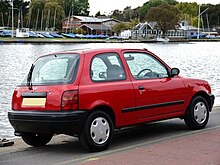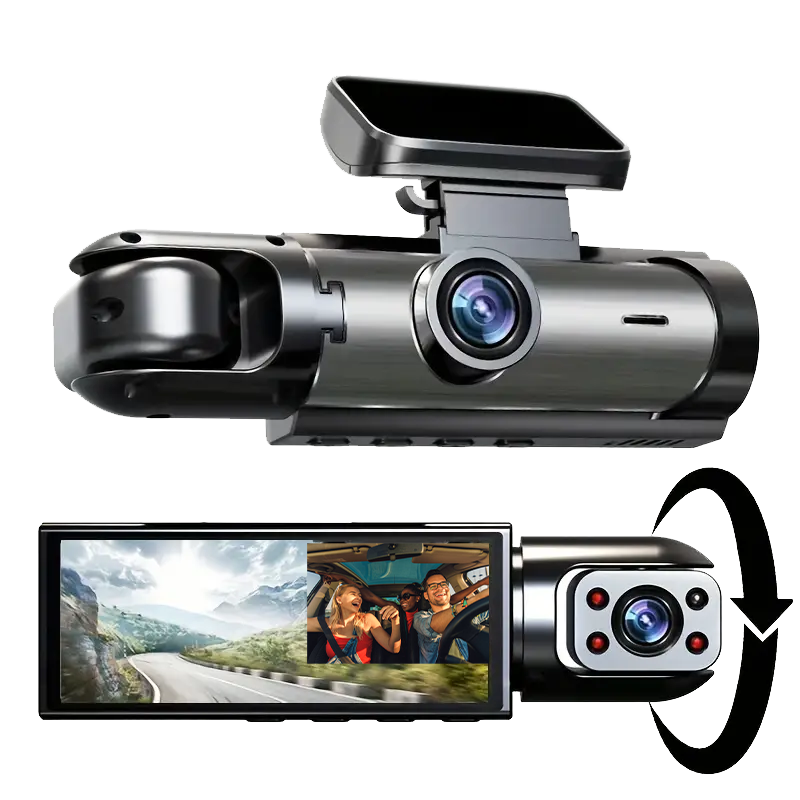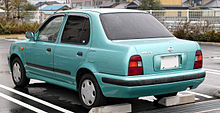
Nissan Micra Second Generation 1992- 2003

| Second generation (K11) | |
|---|---|
 |
|
| Overview | |
| Also called | Nissan March Nissan Verita (Taiwan/Philippines) Mitsuoka Viewt Muji Car 1000 |
| Production | 1992–2003 1993–2007 (Taiwan/Philippines) |
| Model years | 1993–2002 |
| Assembly | Oppama Plant, Yokosuka, Kanagawa, Japan Sunderland, England (NMUK) |
| Body and chassis | |
| Body style | 3-door hatchback 5-door hatchback 2-door cabriolet 4-door sedan (March Cubic) 5-door station wagon (March Box) |
| Related | Nissan Cube (Z10) |
| Powertrain | |
| Engine | 1.0 L CG10DE I4 1.3 L CG13DE I4 1.4 L CGA3DE I4 1.5 L TUD5 diesel I4 |
| Transmission | 5-speed manual 4-speed automatic CVT automatic |
| Dimensions | |
| Wheelbase | 2,360 mm (92.9 in) |
| Length | 3,695–3,746 mm (145.5–147.5 in) |
| Width | 1,585–1,595 mm (62.4–62.8 in) |
| Height | 1,430–1,440 mm (56.3–56.7 in) |
Micra K11 (1992–1997)

Pre facelift Nissan Micra
Taiwan designed pre facelift Nissan March sedan
The second-generation K11 was built in the UK and launched in Japan in early 1992, and released in Europe in the fourth quarter of the year. It was powered by brand new all-aluminium 1.0 L (CG10DE) and 1.3 L (CG13DE) DOHC 16-valve engines, with 55 PS DIN (40 kW/54 hp) and 75 PS (55 kW/75 bhp) respectively (higher outputs were claimed in Japan, according to the JIS rather than DIN/ECE rating), both with ECCS (Electronic Concentrated Control System) fuel injection. It was the second Nissan model line to be produced in the UK at the Nissan Motor Manufacturing UK (NMUK) plant, Washington Tyne and Wear. A diesel version was offered with the 1.5 L PSA TUD market in Europe as Micra 1.5 D. CVT automatic transmission and Power steering was an option on some models, and the equipment list included safety features not usually available in this market segment: a toughened safety-cage and side-impact door beams were standard and pre-tensioning seat-belts and a driver's air-bag were optional. However, the Mk2 Micra scored only a modest two stars in Euro NCAP testing in 1997.Airbags, antilock brakes, electric windows, central locking and air conditioning were as either standard equipment or options on some models in the Micra range. The European model range consisted of 1.0L and LX, 1.3LX, SLX and Super S. The car soon won the European Car of the Year award for 1993 (the first Japanese car to do so) and the Good Design Award (a Trade and Industry Design award in Japan) along with the Car of the Year Japan award in 1992. At its introduction in 1993, it won the Automotive Researchers' and Journalists' Conference Car of the Year award in Japan. Having won several awards, Nissan manufactured the V3 Award edition.
After minor changes in 1996, in 1998, six years after its launch, the Micra received a facelift which saw the whole range get power steering as standard.
There was a Cabriolet (FHK11) unveiled at the Tokyo Motor Show in 1995, but it was not sold until August 1997, with an electric top. These were produced in limited numbers for the Japanese Domestic Market (JDM) only. However, much like the Nissan Figaro, some have been imported into the UK unofficially. There was also an estate version called the March Box (WK11), which was unveiled on November 1999, with a double folding rear seat, along with an automatic transmission four-wheel drive model.
K11C (facelift)
|
In late 1997, a facelift version was introduced, and was built from late 1997 until early 2003. Only a few units were produced in 1997, as most of them started in 1998.
The cumulative visual changes from the first models included a revised front grille and headlights, redesigned front and rear bumpers, oval instead of round side repeater indicators, major changes to the interior and dashboard, redesigned rear light lenses, and a radio aerial repositioned from the top of the right-hand A-pillar to the middle of the roof, towards the rear.
In late 2000, the original facelift was replaced by a second version known as the K11C, While it still looked quite similar from the outside, the engine's had been updated to run on the newer individual coilpack system (where as the earlier models had been fitted with a distributor). As well as this, the secondary catalytic converter was removed and the primary catalytic converter (on the manifold) was enlarged. Other exterior changes included new lights on the bumper, an altered lower body, orange turn signals and minor changes to the interior. Further changes included a redesigned rear wiper which rested horizontally instead of vertically, and the centre high level brake lamp being reduced in size and mounted at the top of the rear window, instead of on the parcel shelf.
The 1.3l (1275CC) CG13DE engine offered in previous K11s were removed in the second facelift, and replaced by a 1,348cc "1.4" unit (CGA3DE). The 1.0l CG10DE remained in the second facelift models but had a slightly higher power output (60HP compared to the earlier 53HP)
In 2001 Muji, the well-known Japanese "non-brand" issued a limited release of 1,000 badgeless and decontented Nissan Marches, only available online. It was intended as an exercise to test their online marketing systems and was sold as the "Muji Car 1000" (ムジ・カー 1000). The rear seat is upholstered in vinyl, the hubcaps are minimal, and the car was only offered in "marble white". The Muji Car 1000 has a four-speed automatic transmission and the 1 litre CG10DE engine.
By late 2002, the new K12 was introduced (although the S and SE models were still being built). They were fully replaced by K12 in early 2003.
|
Bolero

Micra Bolero
The Bolero (also known as the Verita) was a luxury model available in certain markets from 1999 to 2003. It featured a redesigned exterior, and an interior which had leather seats.
Super S

Micra SR
Super S trim was available in 1993–1997, then the name was changed to SR (Facelift); Differences include a slightly faster 3.6 turns lock-to-lock rack, over the standard 3.8 turns, different colour coded front and rear bumpers, colour coded wing mirrors and bump strips, rear wrap around spoiler, front driving lights, remote fuel flap opening, wider 175/60/r13 tyres, rear ash tray, tachometer, more heavily bolstered seats, split folding rear seats and rear speaker shelf as standard. Features such as electric windows and power steering were still optional extras. The only engine available for the Super S was the 75 bhp CG13DE/ 1.3 twin cam 16v engine.









